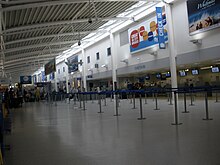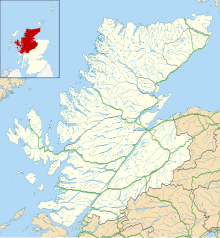Inverness Airport
Inverness Airport Port-adhair Inbhir Nis | |||||||||||||||
|---|---|---|---|---|---|---|---|---|---|---|---|---|---|---|---|
 | |||||||||||||||
| Summary | |||||||||||||||
| Airport type | Private | ||||||||||||||
| Owner/Operator | Highlands and Islands Airports Limited | ||||||||||||||
| Serves | Inverness, Scotland | ||||||||||||||
| Location | Dalcross, Highland | ||||||||||||||
| Elevation AMSL | 31 ft / 9 m | ||||||||||||||
| Website | hial.co.uk | ||||||||||||||
| Map | |||||||||||||||
| Runways | |||||||||||||||
| |||||||||||||||
| Statistics (2013) | |||||||||||||||
| |||||||||||||||
Inverness Airport (Scottish Gaelic: Port-adhair Inbhir Nis) (IATA: INV, ICAO: EGPE) is an international airport situated at Dalcross, 7 NM (13 km; 8.1 mi) north east of the city of Inverness in Scotland. It is owned by Highlands and Islands Airports Limited (HIAL) which owns most of the regional airports in mainland Scotland and the outlying islands.
The airport is the main gateway for travellers to the north of Scotland with a wide range of scheduled services throughout the United Kingdom, and limited scheduled service to Continental Europe. Limited charter and freight flights also operate throughout the UK and Europe. Around 600,000 passengers passed through the airport in 2013.[2]
History
Early years
The airport was originally built by the Air Ministry in 1940 as Royal Air Force station Inverness, or RAF Inverness, or RAF Longman, and in use during World War II from 1940-45. The airport was opened for civil operations in 1947. British European Airways, one of the predecessors to British Airways, commenced flights to London Heathrow Airport in the mid-1970s using a combination of Hawker Siddeley Trident jets and Vickers Viscounts (4-engined turboprops). By the late 1970s and early 1980s there were two daily flights between Inverness and Heathrow, however the route was discontinued in 1983 on the grounds of poor financial performance. Dan-Air inherited the service, offering a three-times daily service using initially a based BAC 1-11 jets followed in the early 1990s by Boeing 737-200 aircraft. The airline sustained the route adding links to London Gatwick and Manchester in the late 1980s, however these new services proved not to be successful and were discontinued.
When Dan Air was bought by British Airways in 1992, the flag carrier retained the service for a further five years, adding a fourth daily frequency shortly before withdrawing the link, amid considerable controversy and public anger, in autumn 1997. British Airways transferred the London service to Gatwick, operated by its subsidiary on a three-times daily basis using lower capacity BAe 146 regional jets. The emergence of EasyJet as a force in UK aviation also coincided with the launch of a daily service to London Luton in 1996. Other destinations and airlines were added (Belfast, Birmingham, Bristol, East Midlands, Leeds-Bradford, Liverpool, Manchester, Newcastle), particularly after 2003, where HIALs's marketing efforts were assisted by route development fund support from the Scottish Executive. The London Heathrow link was re-instated in 2004, by BMI on a daily frequency, however the service was discontinued in March 2008, the airline citing rising costs at Heathrow as the reason.
Development since 2009

In 2009 Ryanair cut its last routes to East Midlands Airport and Liverpool in June, 2009, this was during a review of routes in which Inverness was ranked as one of the worst in the network. The runway is also too short to allow a fully laden B737-800 to take off. Eastern Airways launched services to Manchester and Birmingham using a mix of Jetstream31,Jetstream41 and SAAB2000 turboprops, however, when flybe started flying the same routes in 2008 Eastern decided to withdraw.
International scheduled services proved difficult to successfully establish until the late 2000s, when a weekly seasonal service between Düsseldorf and Inverness commenced in Summer 2009, operated by Lufthansa CityLine, and in 2011 when Flybe commenced daily operations to Amsterdam. The now defunct Snowflake (a low cost subsidiary of SAS) operated a twice weekly service to Stockholm in the summer of 2004, however the service was withdrawn after a short period of operations due to lack of demand. KLM UK operated a daily service to Amsterdam via Edinburgh in 1997 but this was short-lived, lasting only a few months. ScotAirways launched a service to Amsterdam in 2001, however this was withdrawn following the events of 11 September. A four times weekly service to Dublin was operated by Aer Arann between 2006 and 2008 using ATR 42 aircraft before being withdrawn due to the effects of escalating fuel prices.
In 2004 Thomson Holidays, the UK's No1 Tour Operator launched a short series of peak season charter flights to Palma (Mallorca), Ibiza and Lanzarote using a Spanair A320, flights to Palma were maintained (and Costa Dorada (Reus) was added for a couple of seasons) through to 2010. Newmarket Holidays still operates various charters from Inverness on selected dates throughout the year.
The airport terminal is notable as an early example of the Public-private partnership favoured by the UK Government. HIAL was criticised for a PFI deal signed to build a new terminal at Inverness Airport. The deal signed by HIAL meant it had to pay £3.50 for every passenger flying from the airport to the PFI operator. In 2006, the PFI deal was cancelled, costing the Scottish Executive £27.5 million.[3]
The airport is a hub on the Highlands and Islands network where flights between the islands, and other UK and European destinations connect. Flybe (and franchise partner Loganair) is currently the largest operator at Inverness, followed by EasyJet.
The south apron, the main parking area for aircraft, was upgraded in May 2012 to improve access to the terminal by long-range aircraft.[4] In November 2013 the airport’s mile long runway was resurfaced and the taxiway extended, providing a link to the site of the Inverness Airport Business Park.[5]
Airlines and destinations
| Airlines | Destinations |
|---|---|
| easyJet | Bristol, London-Gatwick, London-Luton |
| Flybe | Amsterdam, Belfast-City, Birmingham, Dublin, London-City (ends 22 February 2015), Manchester Seasonal: Geneva, Jersey |
| Flybe operated by Loganair | Benbecula, Kirkwall, Stornoway, Sumburgh Seasonal: Bergen |
Statistics
| Rank | Airport | Passengers handled | % Change 2011 / 12 |
Airlines that operate this route (if operated) |
|---|---|---|---|---|
| 1 | 230,442 | easyJet | ||
| 2 | 89,910 | easyJet | ||
| 3 | 78,072 | easyJet | ||
| 4 | 50,998 | Flybe | ||
| 5 | 36,249 | nm | Flybe/Loganair | |
| 6 | 33,023 | Flybe | ||
| 7 | 26,280 | Flybe | ||
| 8 | 23,903 | Flybe | ||
| 9 | 16,810 | Flybe/Loganair | ||
| 10 | 4,244 | Flybe/Loganair | ||
| Source: UK Civil Aviation Authority[1] | ||||
Ground transportation
Bus
Improved bus services are now operating between Inverness Airport, Inverness and Nairn. Stagecoach in Inverness route 11/11A runs every 30 minutes between the airport and Inverness city centre close to the railway station.
Rail
There is no station at Inverness Airport, although the Aberdeen to Inverness Line runs along the southern perimeter of the airfield. A new station at the airport has been proposed recently, however at present the nearest stations are Nairn or Inverness, both about 9 mi (14 km) away.
Road
The airport is located 7 NM (13 km; 8.1 mi) northeast[1] of the city of Inverness just off the main A96 Aberdeen-Inverness trunk road and is clearly sign-posted from all directions.
Taxis are available directly in front of the terminal building.
Highland Aviation Museum
This museum is situated in the Dalcross Industrial Estate immediately adjacent to the airport. It has four complete aircraft and several aircraft noses on display. The museum is open to the public at weekends and bank holidays.
References
- ^ a b Inverness - EGPE
- ^ a b UK Annual Airport Statistics
- ^ "Deal to buy out airport terminal". BBC News. 20 January 2006.
- ^ "Work to start on Inverness Airport upgrade". BBC News. 9 May 2012.
- ^ Munro, Alistair (5 November 2013). "Inverness Airport upgrade gets underway". The Scotsman. Retrieved 25 November 2014.
External links
![]() Media related to Inverness Airport at Wikimedia Commons
Media related to Inverness Airport at Wikimedia Commons

